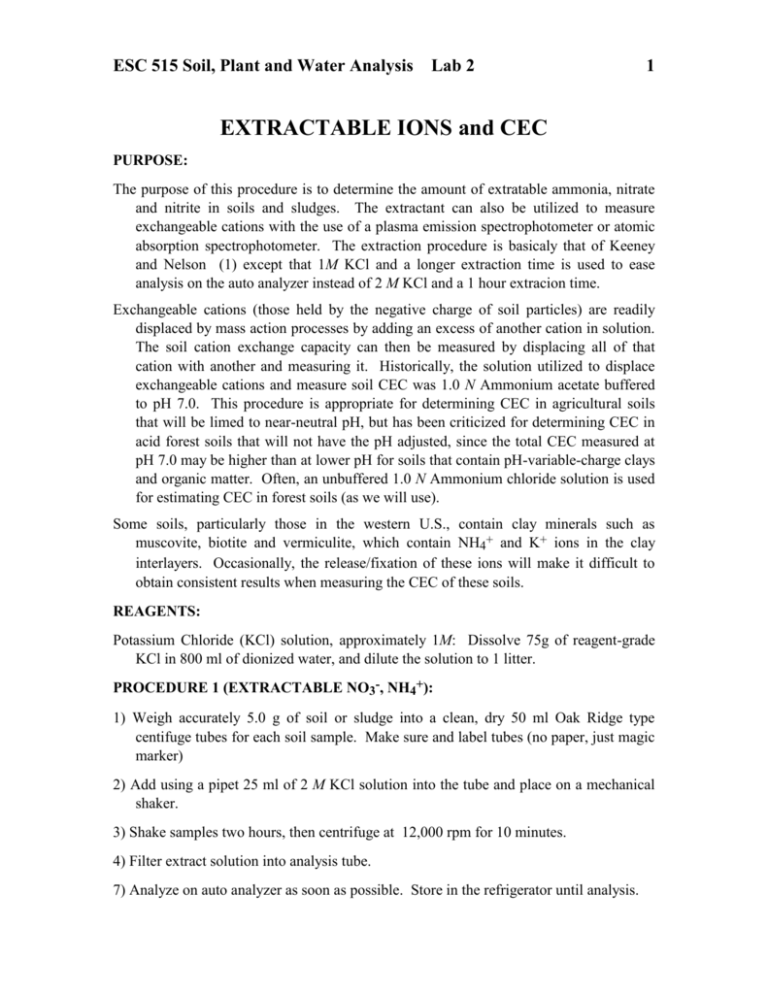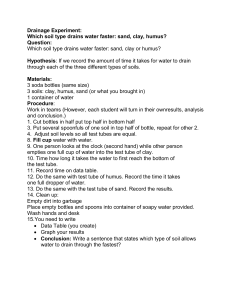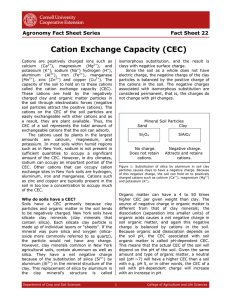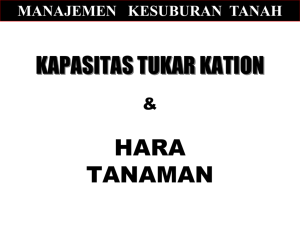ESC 515 Soil, Plant and Water Analysis Lab 2 1 EXTRACTABLE
advertisement

ESC 515 Soil, Plant and Water Analysis Lab 2 1 EXTRACTABLE IONS and CEC PURPOSE: The purpose of this procedure is to determine the amount of extratable ammonia, nitrate and nitrite in soils and sludges. The extractant can also be utilized to measure exchangeable cations with the use of a plasma emission spectrophotometer or atomic absorption spectrophotometer. The extraction procedure is basicaly that of Keeney and Nelson (1) except that 1M KCl and a longer extraction time is used to ease analysis on the auto analyzer instead of 2 M KCl and a 1 hour extracion time. Exchangeable cations (those held by the negative charge of soil particles) are readily displaced by mass action processes by adding an excess of another cation in solution. The soil cation exchange capacity can then be measured by displacing all of that cation with another and measuring it. Historically, the solution utilized to displace exchangeable cations and measure soil CEC was 1.0 N Ammonium acetate buffered to pH 7.0. This procedure is appropriate for determining CEC in agricultural soils that will be limed to near-neutral pH, but has been criticized for determining CEC in acid forest soils that will not have the pH adjusted, since the total CEC measured at pH 7.0 may be higher than at lower pH for soils that contain pH-variable-charge clays and organic matter. Often, an unbuffered 1.0 N Ammonium chloride solution is used for estimating CEC in forest soils (as we will use). Some soils, particularly those in the western U.S., contain clay minerals such as muscovite, biotite and vermiculite, which contain NH4+ and K+ ions in the clay interlayers. Occasionally, the release/fixation of these ions will make it difficult to obtain consistent results when measuring the CEC of these soils. REAGENTS: Potassium Chloride (KCl) solution, approximately 1M: Dissolve 75g of reagent-grade KCl in 800 ml of dionized water, and dilute the solution to 1 litter. PROCEDURE 1 (EXTRACTABLE NO3-, NH4+): 1) Weigh accurately 5.0 g of soil or sludge into a clean, dry 50 ml Oak Ridge type centifuge tubes for each soil sample. Make sure and label tubes (no paper, just magic marker) 2) Add using a pipet 25 ml of 2 M KCl solution into the tube and place on a mechanical shaker. 3) Shake samples two hours, then centrifuge at 12,000 rpm for 10 minutes. 4) Filter extract solution into analysis tube. 7) Analyze on auto analyzer as soon as possible. Store in the refrigerator until analysis. ESC 515 Soil, Plant and Water Analysis Lab 2 2 8) All results should by reported on an oven dry basis. NOTE: After centrifuging same samples may have organic material that has not settled. These samples can be filtered using Whatman #41 filter paper. PROCEDURE 2 (EXCHANGEABLE CATIONS): Equipment Mechanical extractor extractor tubes sample bottles 100 ml volumetric flasks Reagents Ammonium chloride solution (NH4Cl), 1.0 N Ethanol Procedure 1) Weigh out 1.0 g of filter pulp into each extracting tubes. 2) Weigh out accurately 5.0 g of air-dried soil into each extracting tubes. Exchangeable cations 3) Assemble extraction tube assembly onto mechanical extractor as shown in Figure 1. 4) Add 10 ml of extracting solution to middle tube and mix with stir rod to assure allof soil is in contact with solution. 5) Fill reservoir (top tube) with 40 ml of extracting solution (1 N Ammonium chloride). 6) Turn on extractor and extract for 12 hour period. 7) Following 12-hour extraction period, collect leachate and re-extract with 50 ml of additional solution. 8) Collect leachate in same container as in 6); transfer to 100 ml volumetric; dilute to volume, and analyze sample for cations by Atomic absorption or plasma methodology. ESC 515 Soil, Plant and Water Analysis Lab 2 3 CEC 9) Disassemble upper tube assembly and rinse thoroughly with ethanol. 10) Rinse sides of middle tube with ethanol. 11) Add enough ethanol to assure an excess. 12) Extract for 1 hour period. 13) Discard leachate, add additional 50 ml of ethanol and extract for 1 hour period 14) Add 50 ml of 1 N KCl, extract for 12 h, and collect leachate for analysis for CEC. 15) Save solutions collected in 14) and 15) above, dilute to volume in a 100 ml volumetric flask, and keep sample for analysis of NH4+ by autoanalyzer methodology. Alternately, the solution can be analyzed by Kjeldahl methodology CALCULATION: µg/g = (ppm)(100 ml + H 2O in sample) (dry wt.)









